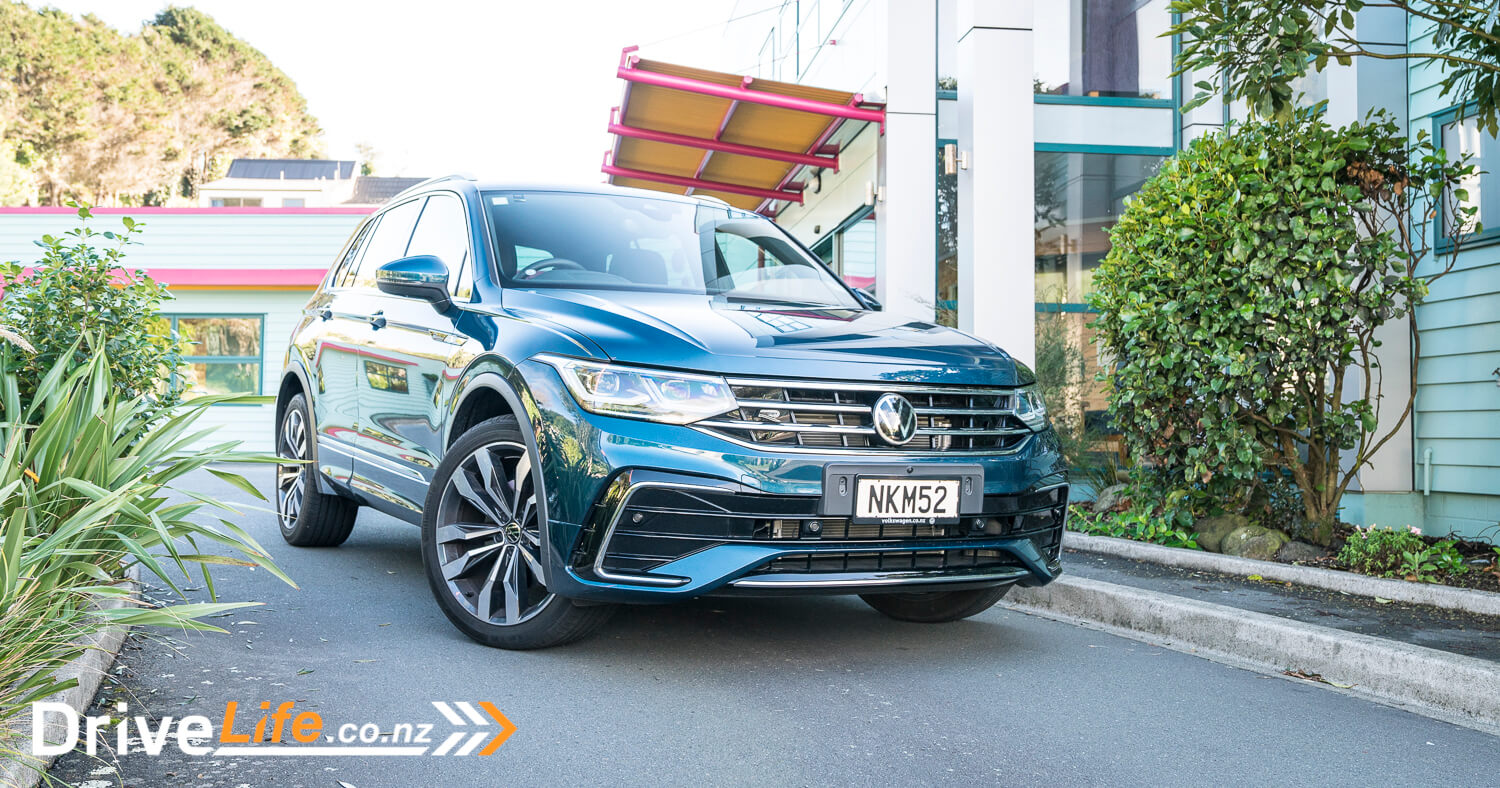SUVs are everywhere, such a big part of our lives now. Anyone with a family who has one will know that it’s a game-changer, much more practical than a sedan or wagon. Easier to get small kids in and out of and a stronger sense of safety due to their size. But they can be a bit on the boring side too, which is where vehicles like the 2021 VW Tiguan TSi R-line 4WD come into their own. It sits somewhere in the middle of the range, with a mixture of all the practical stuff, while having a sporty fun side too.
This Tiguan was a perfect car for me to review as my wife has this exact model. We bought it new in 2018, trading in our 2006 VW Golf R32 for a VW Tiguan R-Line 4WD. My wife loved her R32, and even though she knew that an SUV was the way to go since our daughter came along, she wanted something that would still be fun to drive. The review car is the same generation so this is more of a facelift rather than a new model. I was curious to see what changes VW had made, as this could highlight any design or usability issues with our Tiguan.
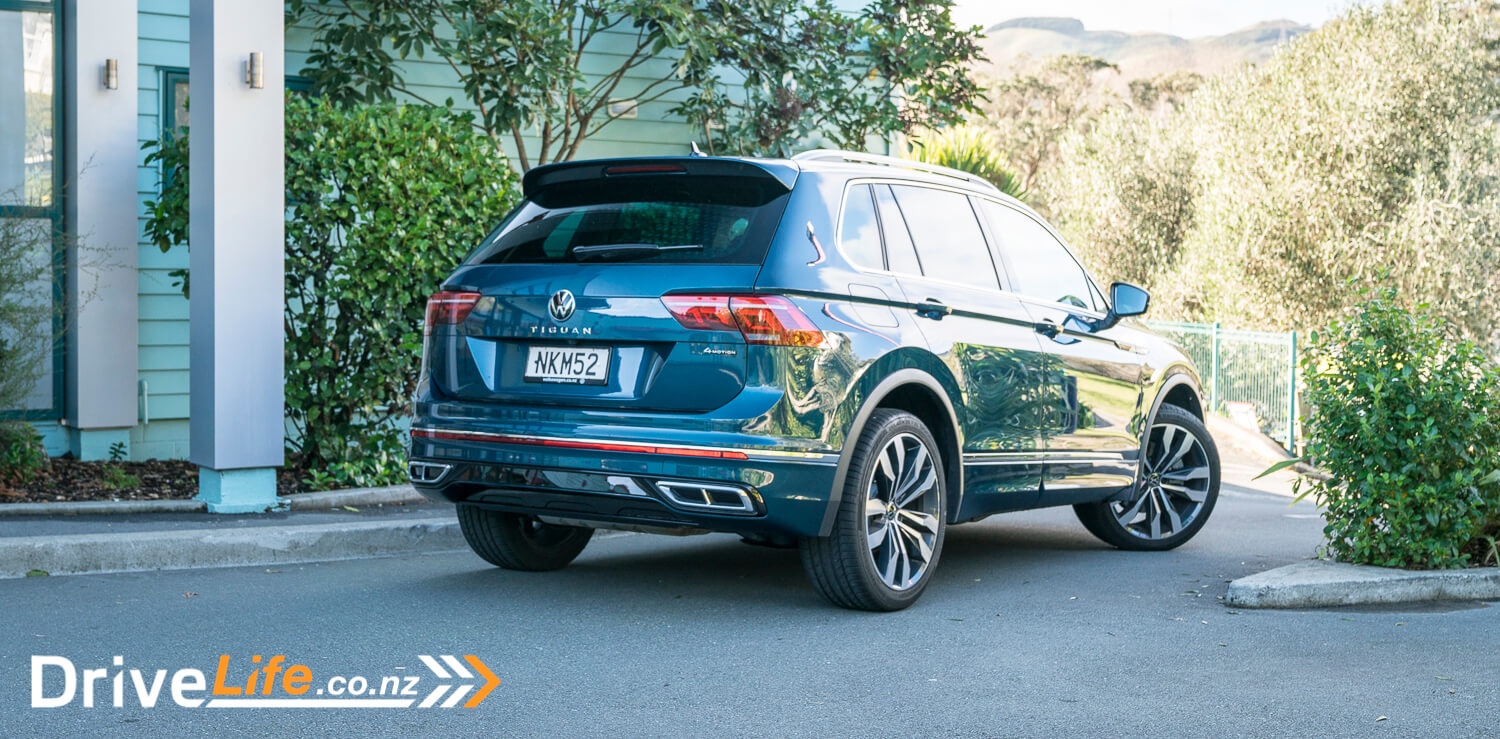
What’s In The 2021 Volkswagen Tiguan Range?
There are 4 variants available in New Zealand, the range starts with the TSI Life 2WD (starting from $46,990), moves up to the TSI R-Line 2WD (from $55,990), then you have a TSI Style 4WD available after August (from $55,990), and our review car the TSI R-Line 4WD (from $68,990).
The range shares two engine variants, a 1.4-litre and a 2.0-litre 4 cylinder turbo petrol engine. Both the TSI Life 2WD and the TSI R-Line 2WD share the same 1.4-litre engine. This creates 110Kw of power and 250Nm of torque and has a combined fuel consumption of 7.6 litres per 100km. The TSI Style 4WD and TSI R-Line 4WD also share the same engine, however, they are tuned differently. The TSI Style has a 2.0-litre turbo petrol engine that creates 132kW of power and 320Nm of torque and combined fuel consumption of 8.6-liters per 100km. The TSI R-line 4WD has the same 2.0-liter engine but is tuned to create 162kW of power and 350Nm of torque. This tune has also resulted in better fuel economy, of 8.3-litres per 100km.
Spec levels are high even on the base model, with the TSI Life coming with a raft of features. These include stability programme (ESP), electronic differential lock (EDL), anti-slip regulation (ASR), trailer stabilisation, driver and front passenger front airbags, driver and front passenger-side airbags, curtain airbags (front and rear), driver knee airbag, ISOFIX mounting points on outer rear seats (x2), child seat top tether anchorage points on outer rear seats (x2), anti-theft ‘plus’ alarm system, seatbelt reminder (front and rear seats), 3 point seat belts for all passengers, proactive occupant protection system, front assist incl. autonomous emergency braking and forward-collision warning, pedestrian monitoring, adaptive cruise control (ACC) with travel assist and emergency assist, tyre pressure loss indicator, a rearview camera with dynamic guideline, park distance control (front and rear parking sensors), electromechanical power steering, standard LED headlights with headlight range, LED daytime running lights (DRL) adjustment, KESSY smart key, push-button and keyless entry/locking, electronic parking brake with auto hold, climatronic 3-zone air conditioning system, height and reach the adjustable steering wheel, and leather-covered multifunction steering wheel with gearshift paddles. Not bad for the $46,990 entry variant.
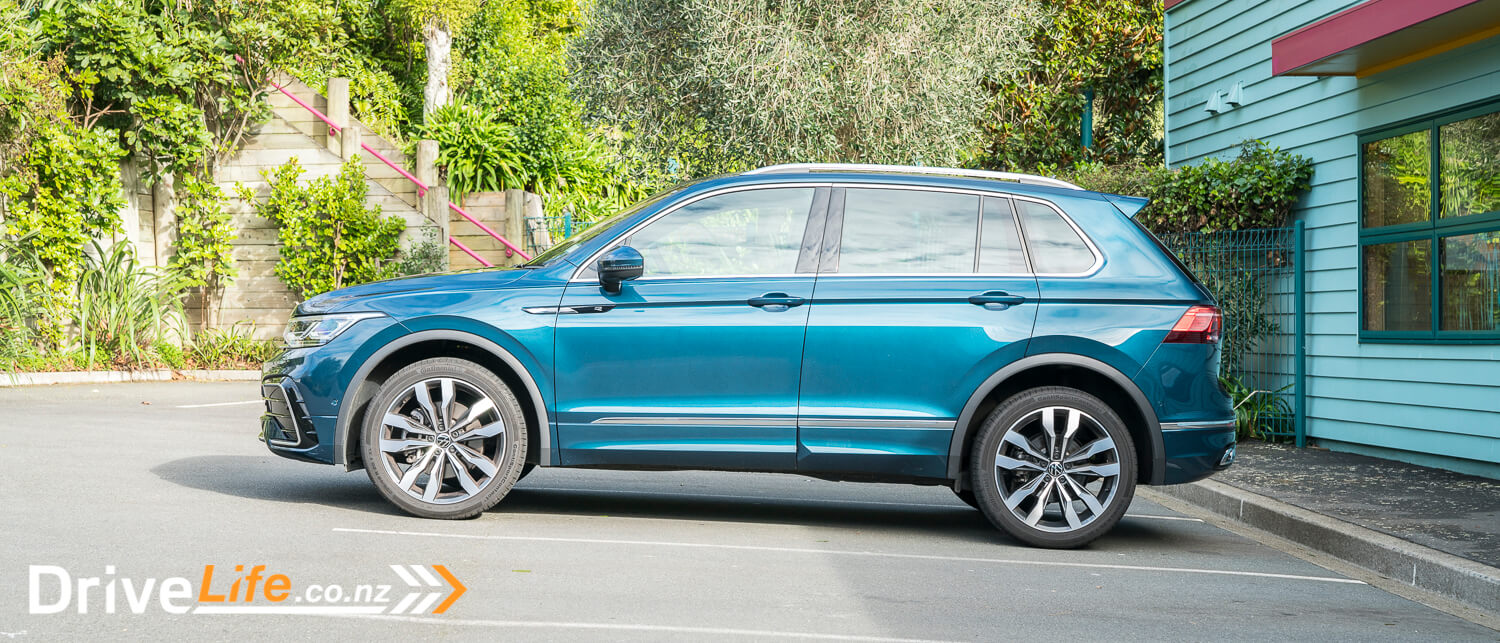
There are some small differences between the TSI R-Line and TSI Style, which you can check out on the VW New Zealand website. As our focus in the TSI R-Line AWD, I will outline the additional features this has over the base model. These include side airbags at the rear (outer rear seats), hill descent control, area view camera, driving profile selection (Normal, Sport, Eco, Comfort and Individual), 4MOTION active control (On-road, Off-road, Off-road individual and Snow), adaptive chassis control (DCC), electrically controlled dampers, ‘IQ. light matrix LED headlights with automatic headlight range adjustment, dynamic light assist (automatic high beam control), dynamic cornering lights and ‘R-Line’ leather-covered multifunction sports steering wheel with gearshift paddles.
There are a lot more trims and features on the Tiguan R-Line, so for a full list of specs and options available for the Volkswagen Tiguan R-Line, jump on over to the VW New Zealand Website.
What’s Our First Impressions Of The 2021 Volkswagen Tiguan TSI R-Line?
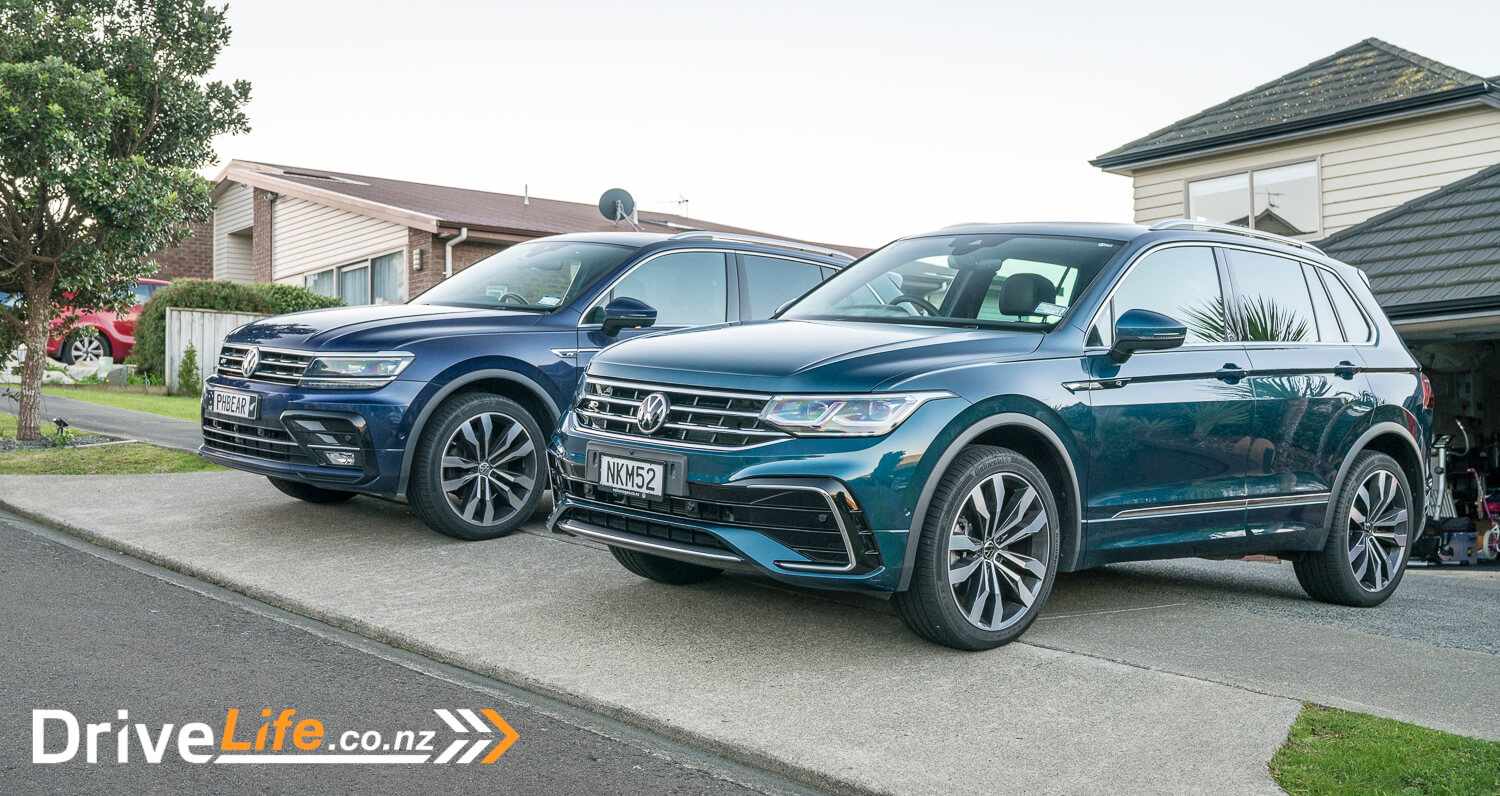
As I mentioned we have 2017, a VW Tiguan R-Line 4WD in dark blue. So our first impression of the new Tiguan was a bit strange, as it looked just like the car we owned. As coincidence would have it, the two cars are spec’d the exact same, same wheels and almost the same colour, what are the odds. At a glance, I would not have been able to tell them apart, but the more you look when they are side by side you see that there are many differences to the latest version of the Tiguan R-Line which we will go into in more detail later.
When comparing old and new, you can see the evolution. The front has been sculpted to have a more aggressive and sporty look, larger grille with a new logo and bigger intakes. The side of the car sees little change with just a different vent trim behind the front wheels. The rear has the new logo too and Tiguan is larger lettering just below it centralised on the tailgate. Sadly the rear bumper still has the fake exhaust tips, just more pronounced in the latest model.
As the Tiguan felt similar to the car we owned, first impressions were good, as we really like our Tiguan.
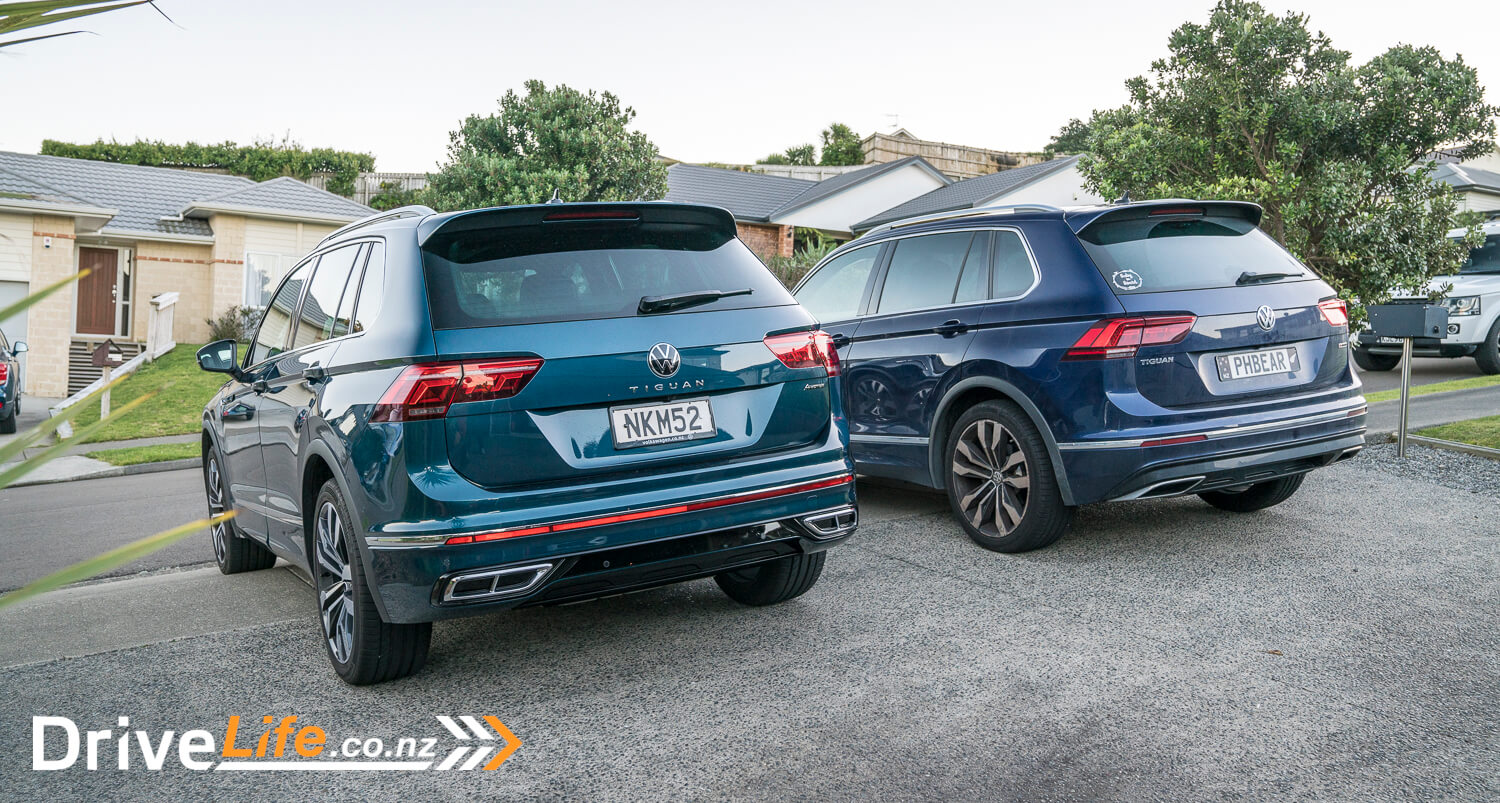
What’s The Inside Like On A 2021 Volkswagen Tiguan TSI R-Line?
In the driver’s seat, there are not a lot of changes. The only real differences are that there is a different steering wheel, buttons below the central media display and drivers display have been upgraded. Pretty much everything felt or looked the same as our own car.
The seats have not changed, still very very shaped, focused on comfort with a sporty flair. The side bolsters on the front seats are a bit more pronounced when compared to the rear. The driver’s seat is fully electrical while the passenger seat is manual. The rear seats can also slide back and forth to give a bit more legroom. There is really good legroom in the back of the Tiguan as the seating position is higher than most cars, so your legs are placed more like a dining chair than a car. Overall the space and comfort in any seat was pretty good.
The new steering wheel is new too, overall a similar feel, but with a more modern clean vibe. The old silver badge has been replaced with a slight embossed black badge. The controls on the steering wheel and surround stalks are all the same too. Giving you access to speaker volume, all the cruise control settings, driver display information and the heated steering wheel. The only thing, and I think it’s the only change that I did not like, is the addition of haptic buttons on the steering wheel. Very aggressive haptic buttons too, it does not feel nice to use at all. I found it very distracting and just avoided using them. My wife did not like them either. We looked to see if they could be disabled, but we were not able to find the options. I do hope it’s there somewhere, as this could be a deal-breaker.
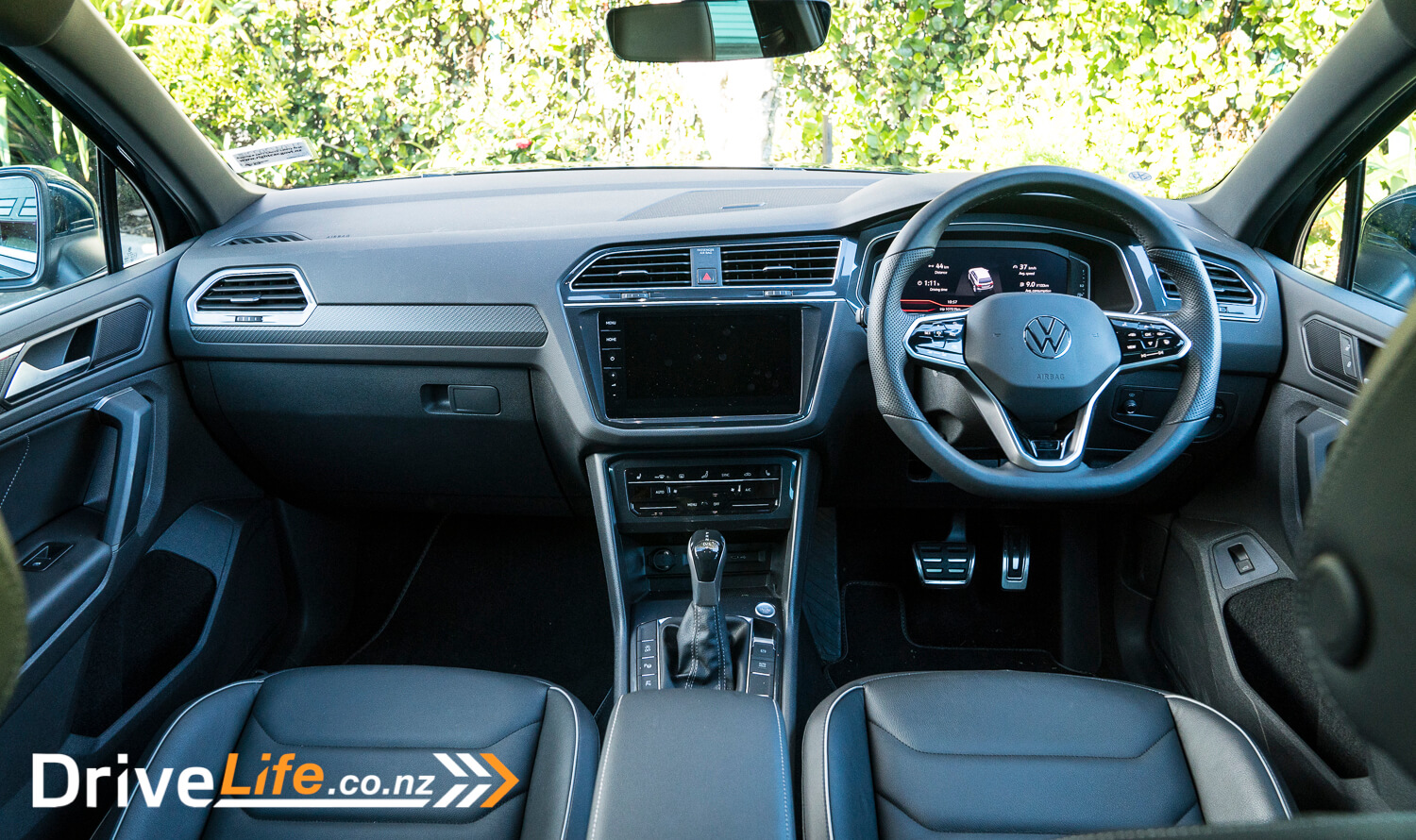
The centre console has only seen one change, that is to the gear knob. The same buttons surround the gearstick, auto stop-start on and off, park assist, parking camera and sensors, engine start/stop, park brake and auto hold. Above this area is a nice space to be able to put things, wallets, phones, etc. In here it was also nice to see the addition of USB C ports, which should enable fast charging on mobile devices.
Above this area and below the screen, are the controls for the AC, seat heaters and air vent circulation system. This has changed from twist dials and push buttons to a touch-sensitive solid panel. There are no buttons and it’s not haptic. It’s one panel that has all of the different buttons printed on it. When used by touching the panel or sliding your fingers from left to right for the AC temperature, the button either shows adjustments on the display or lights up if turned on. I really liked how simple it was, carrying it on from the Golf we had just been reviewing too, simple and clean.
The media screen is the same as the previous model, with the improvements to Apple CarPlay and Android Auto, both now working wirelessly. The options here are pretty standard, with controls for the radio, phone, navigation, driver assist, media, sound and overall vehicle settings. The menus are simple and easy to navigate, without too many levels that you have to dig to find what you are looking for. Additionally when you switch between the driver profiles, which can be selected via the circular dial on the centre console. This menu then displays on the central screen, showing Eco, Comfort, Normal, Sport and Individual for selection.
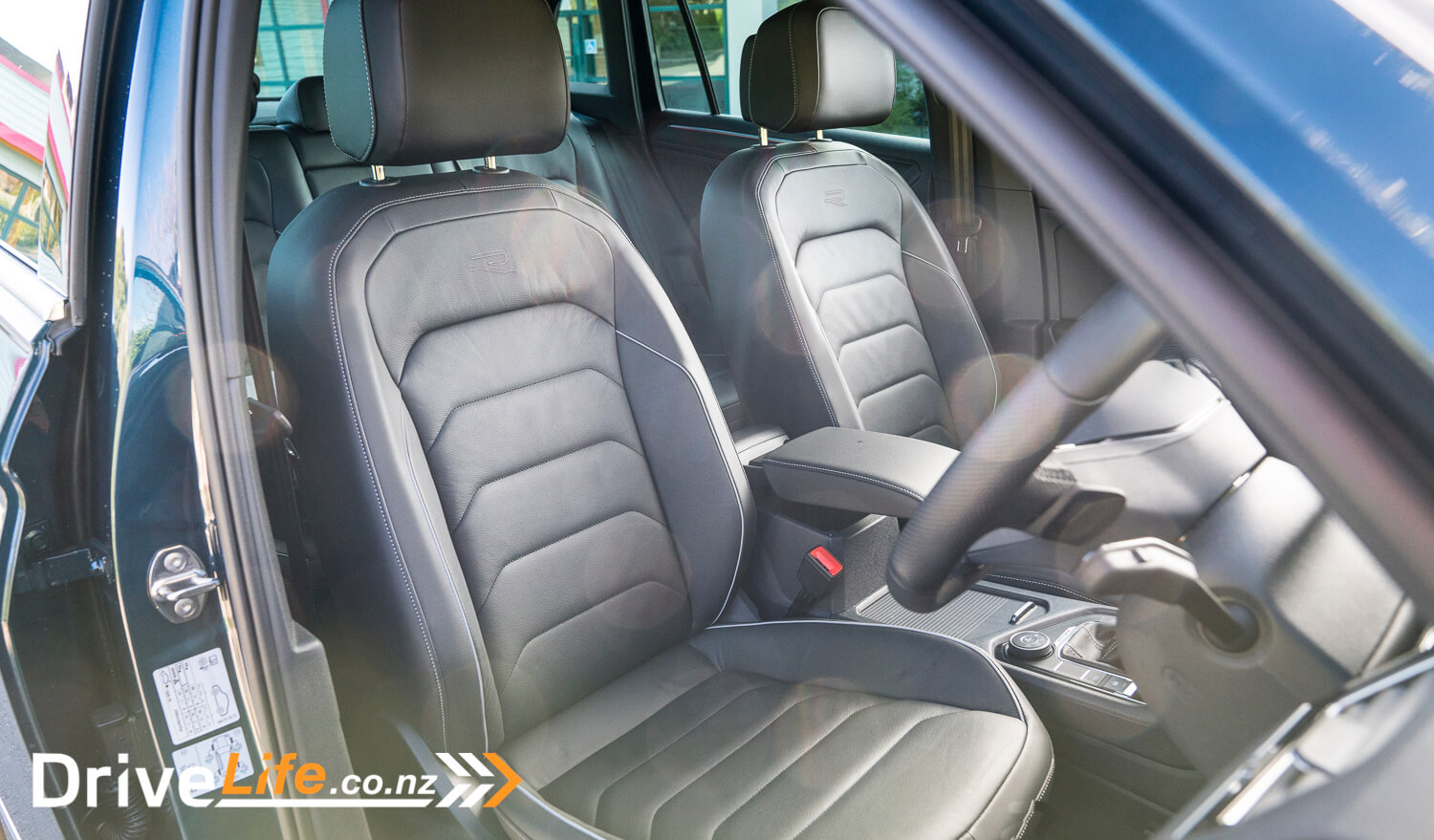
The driver’s dash has been improved upon with a cleaner and edgy design. Even though the previous model also had a full LCD driver display, the new one has removed the old digital dials for a less cluttered display surrounding the map. It’s still got everything you need plus its moved the engine temperature and fuel gauge to the side as vertical LED lights. Even my wife commented that the new display was a lot cleaner than the old one.
The head-up display was nice, again like our model, it was a plastic screen that came up out of the dash when the car was started. It was simple and it worked fine. I did find that the angle of the HUD screen had to be set rather low for my eyes to see it, which meant it was on the bonnet instead of floating in front of the car. I was sure this was not the case in our Tiguan, maybe something changed around the HUD positioning.
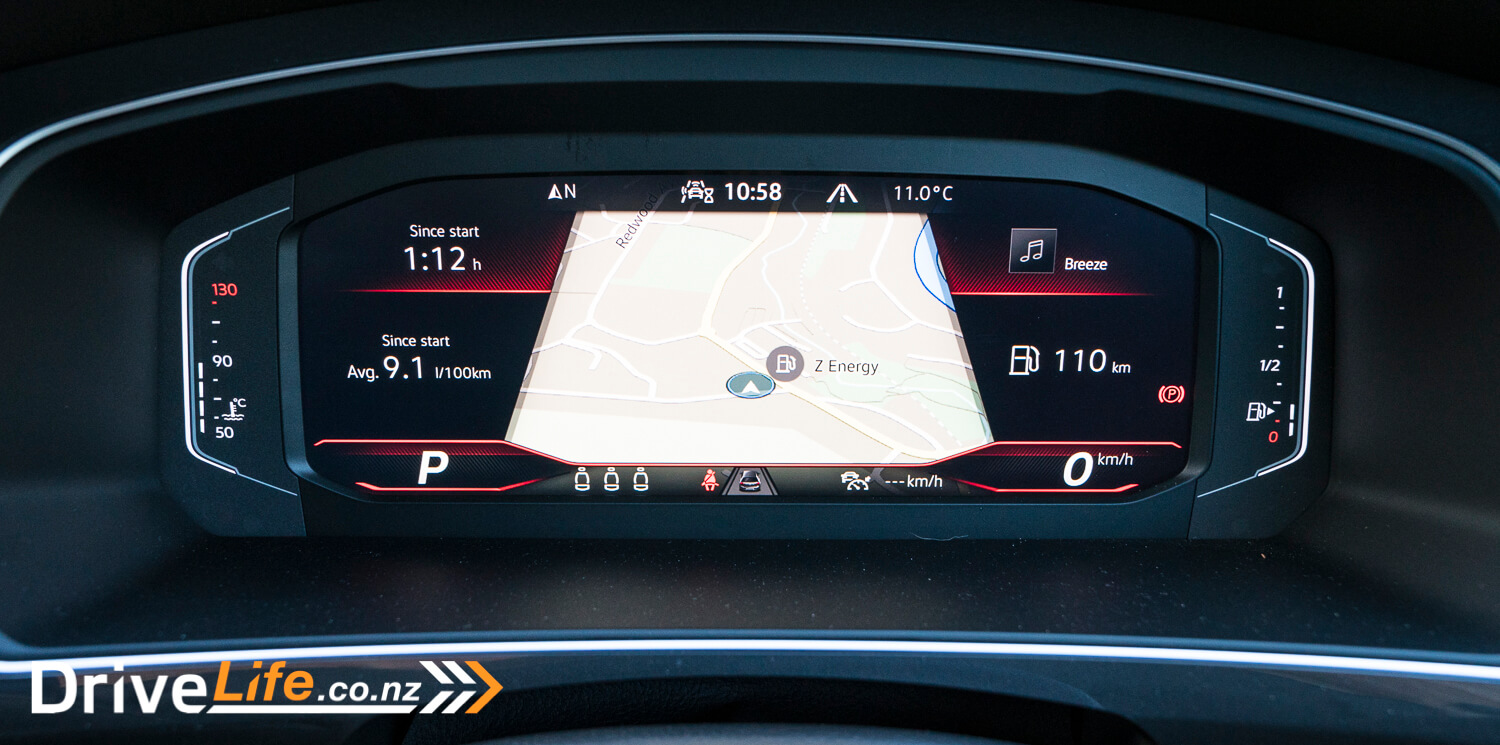
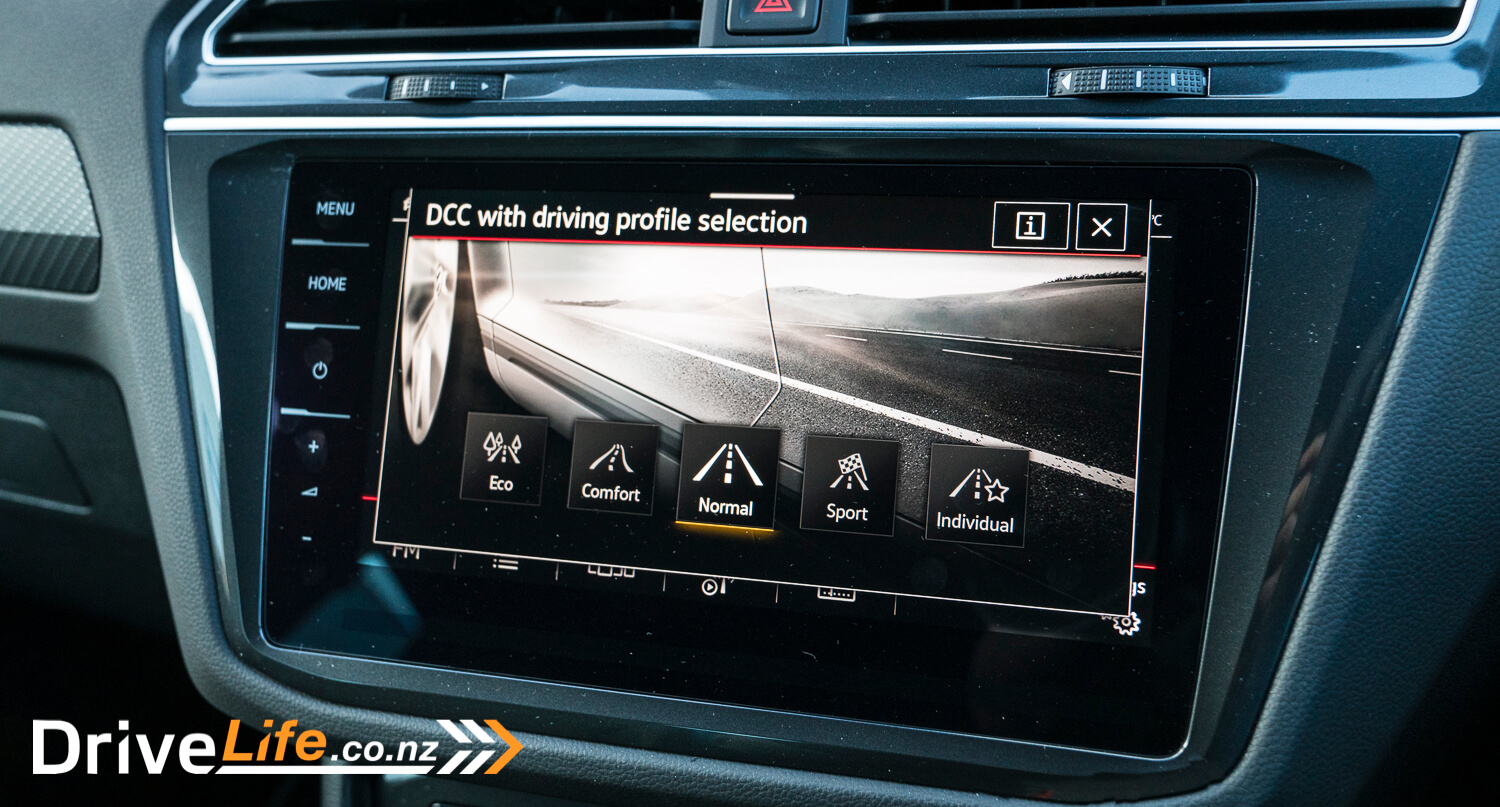
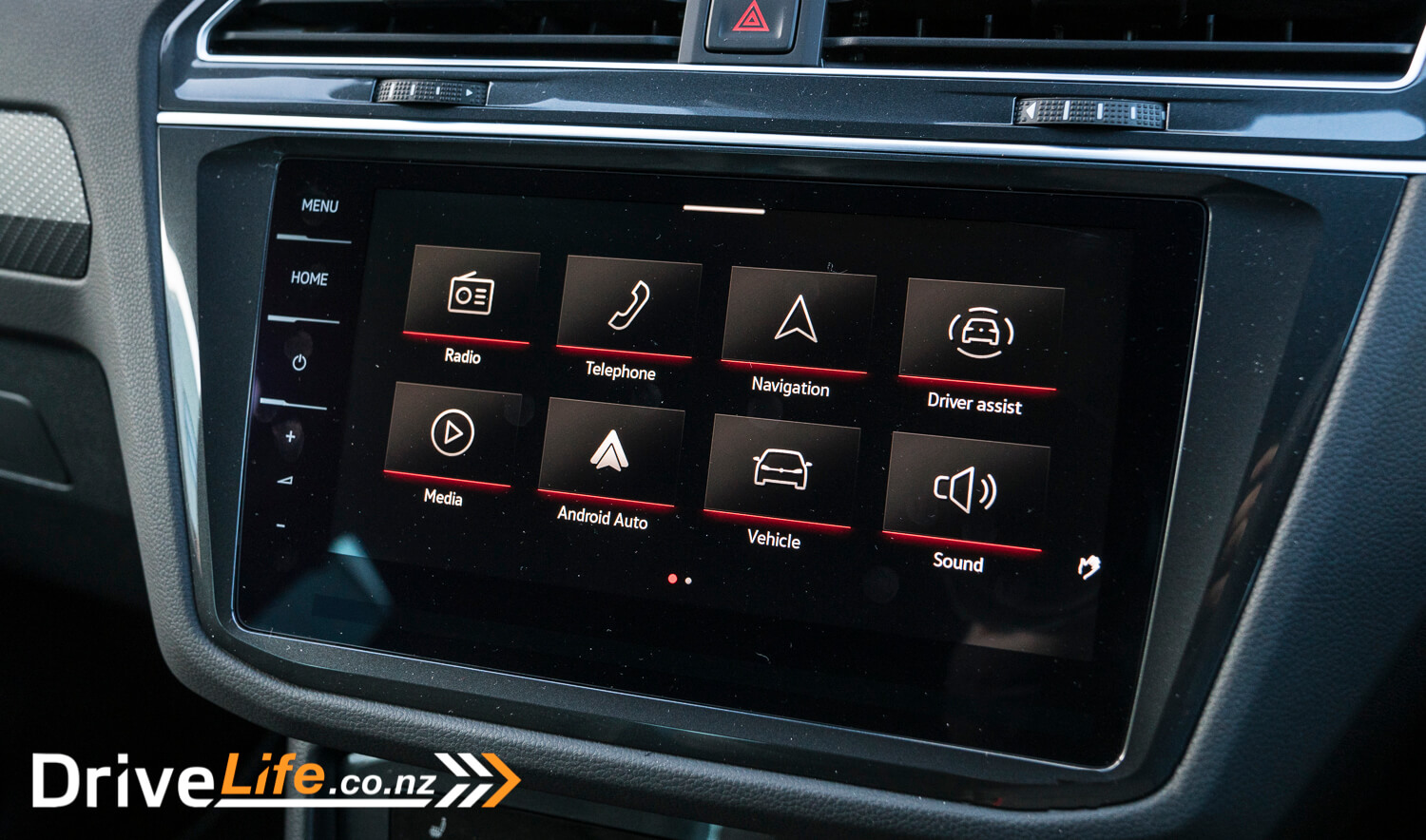
One item that was in the previous model, and not in the review car, was the fold-up tables on the back of the drivers and passenger seats. These tables have been great for our daughter, she can use them for food, activities or while watching her tablet on long trips. It was a shame to see this feature removed.
The boot space is really good, as the level of the floor is at a good height to load items, while still being a large space. With the rear seats up it’s a generous 615 litres and with them down it turns into a very large 1655 litres. On either side of the boot opening, there are two sunken pockets that can be used to stow items that may roll around the boot. Under the floor of the boot, you still have a space saver. This is not my preference, but the 20 inch rims are big and it’s not practical to have a full-size spare. I fully understood this a few weeks ago as I had to change my wife’s flat tyre in the dark and rain so she could go to work.
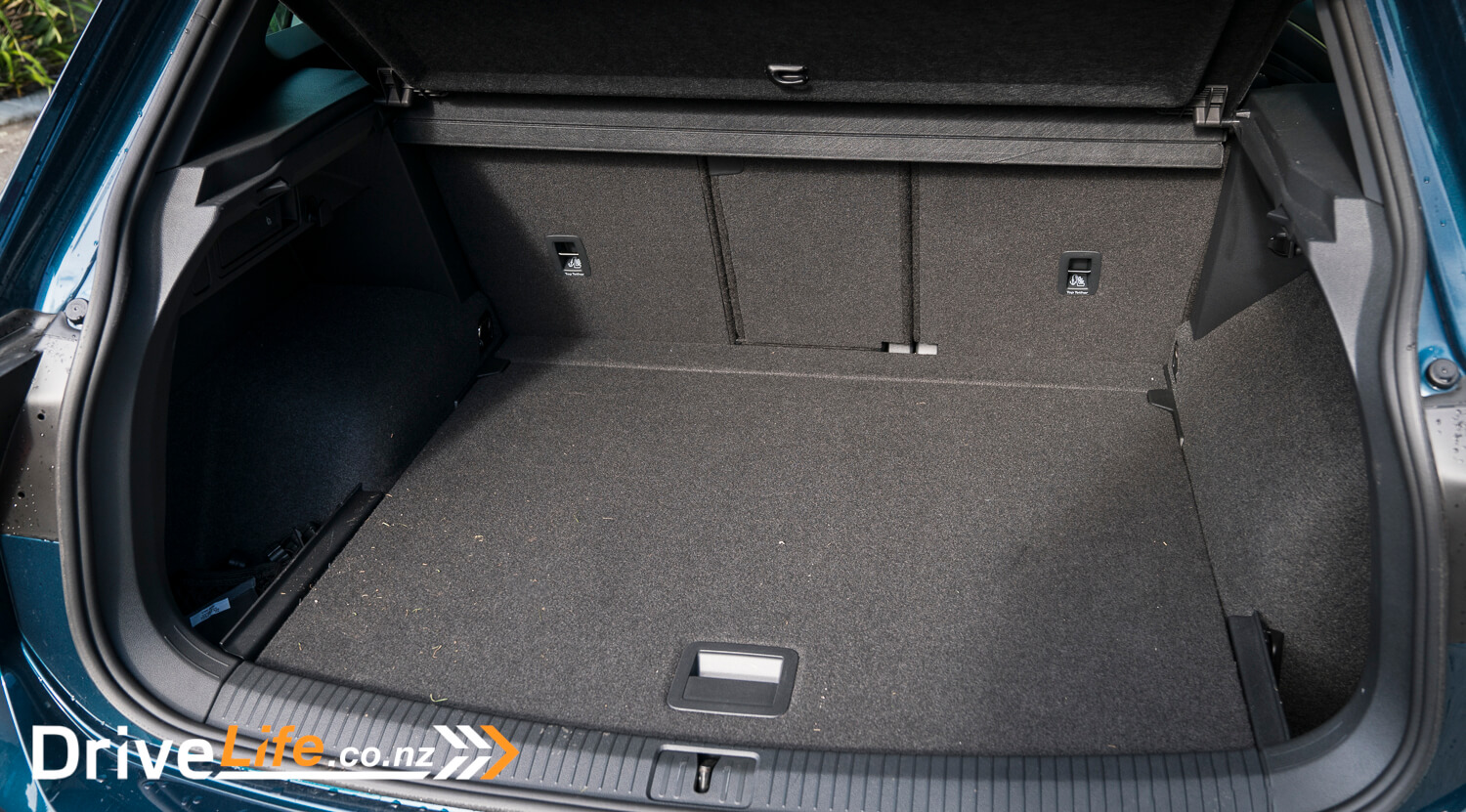
What Does The 2021 Volkswagen Tiguan TSI R-Line Drive Like?
The ride in the Tiguan was great, when in normal mode the car soaked up a lot of the road. This was also combined with a good level of feel from the steering wheel, which gave the driver confidence about the road conditions and their ability to place the car on the road or in corners. It was easy to feel confident behind the wheel of this car, and even if you pushed it a bit on some twisty roads, you never lost faith. I even had a bit of fun while I was testing it.
Cabin noise was acceptable, good considering the low profile tyres. Easy to have a conversion in the car with passengers in the back seats.
I did find the brakes were a bit grabby, I was not sure if it was just the fact they were new brakes. However, I did find myself being thrown forward a few times when I got on the brakes quicker than I thought I had. This is not a bad thing, something any driver would get used to with a bit of time behind the wheel.
Like many cars around this level that have driver profiles, you tend to only use one or two modes. In the Tiguan, Eco, Comfort, Normal, Sport and Individual. It was hard for me to work out what the difference was between Comfort and Normal, there didn’t appear or feel like much change to the vehicle. So Normal became the default go-to. Eco is an odd one, this could be called slow or lazy mode, which means all the instructions you feed the vehicle are related or acted on slowly. If you feed the power on, it comes on slower than normal. The overall feeling is rather lethargic. The sport was the second go-to mode, which did what is said on the tin. Sport set the car into a quick action state of awareness, where your orders were actions on very quickly. The gear changes were left longer and it generally stayed in a lower gear ready for action.
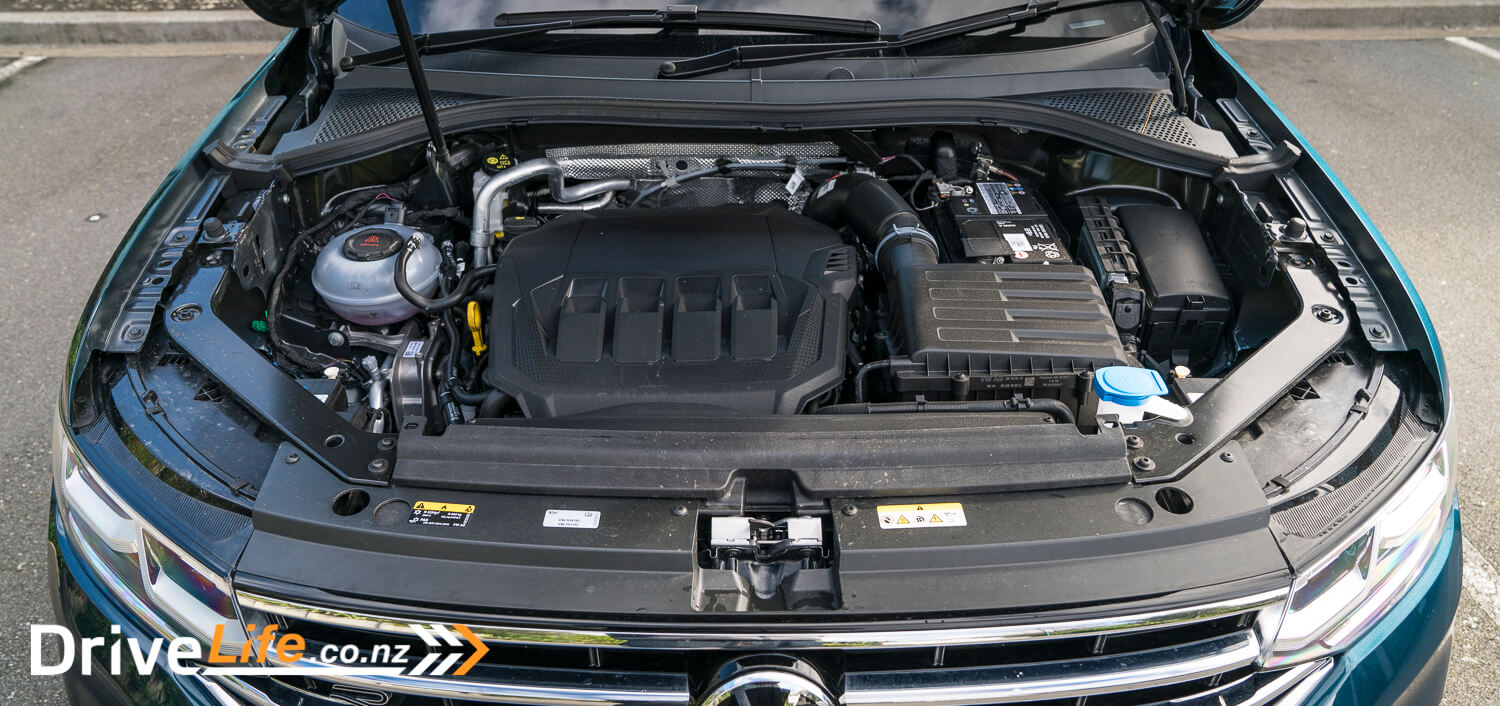
The Tiguan is surprisingly sporty or what it is. The 2.0-litre does not create mind-blowing figures, 162kW of power and 350Nm of torque. But thanks to the 7 speed DSG, the Tiguan can pick up and go at a very sporty pace. VW claims the 0-100km/h is 7.0 seconds, but it feels quicker than that behind the wheel.
In the same way, other VW products can quickly go from normal to sports performance with a pull-down on the gearstick. The new Tiguan did the same, which changed the drive mode from D to S. This is great for when you’re getting on the motorway or want to have a bit more pep in your step when overtaking. Quick pull back on the gearstick, foot to the floor and away you go. Then once your manoeuvre is completed, it’s a quick pull back on the stick to switch back into D once again.
The fuel economy of the new Tiguan is claimed to be 8.3-litres per 100km. Over my time behind the wheel, I was getting a combined fuel consumption figure of 9.1-litres per 100km. That’s not bad in terms of the advertised figures. I think with a bit more normal driving this figure could have been even closer.
The main things both my wife and I love about our Tiguan was that it never felt like a big SUV. It had the same feel to drive like a hot hatch, light on its feet, quick and nimble around the city too. I daily drive a Land Rover Discovery 4, which is a tank, and that’s exactly what it feels like to drive. But the Tiguan gives you what you want from an SUV without having to suffer from that big SUV feel. As far as the driving experience goes, my wife and I didn’t feel there was much change in the latest Tiguan. We both enjoyed driving it and feel it still performs as well as our Tiguan does.
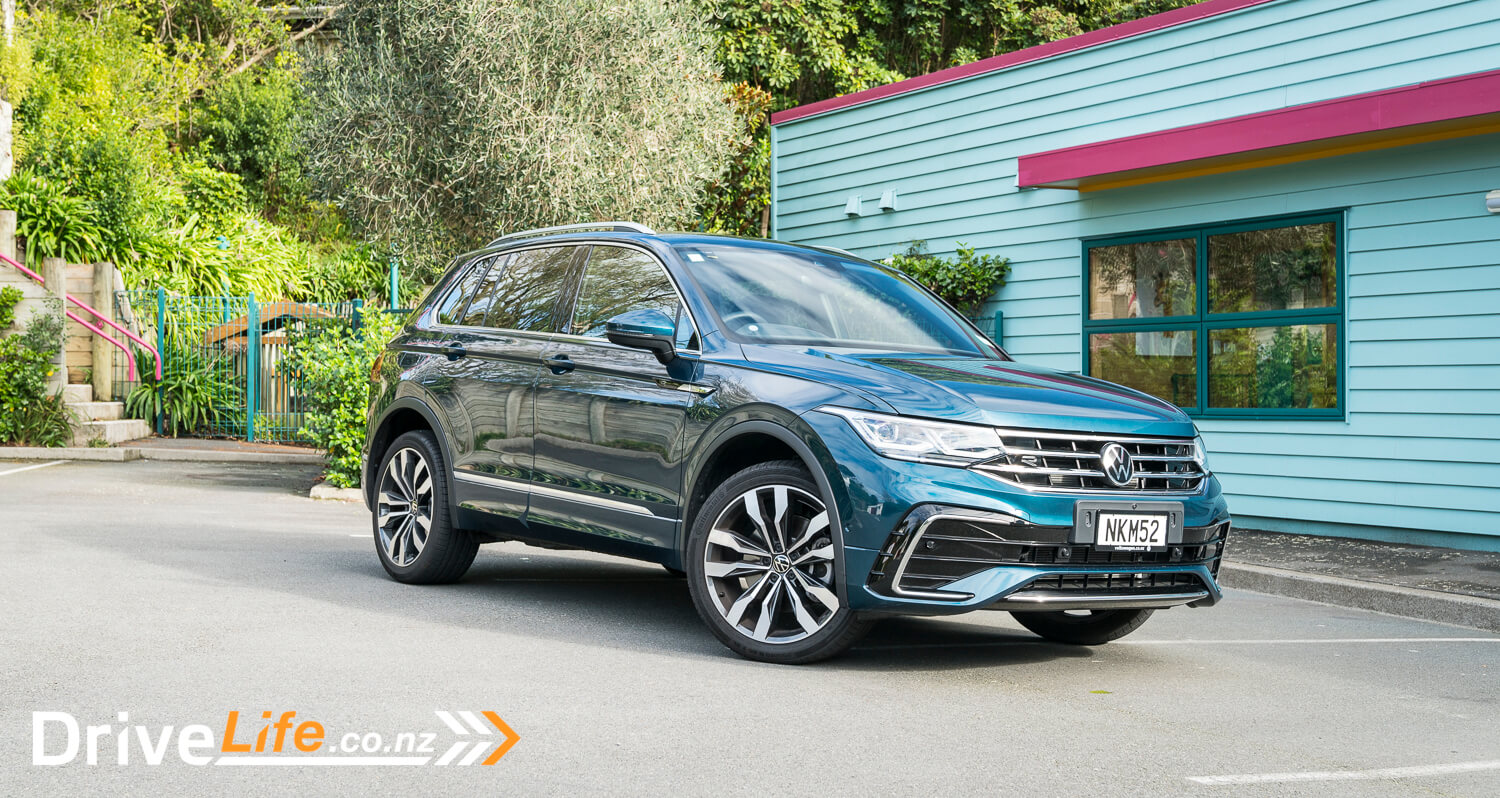
Fred’s point of view
I have to admit, I’d never driven a Tiguan. I’ve seen them all around town, seemingly a very popular SUV. After a week with the car, I can see why. They drive extremely well, and the level of finish inside is outstanding. The mix of materials used is brilliant, and while it did feel like I was driving a bus at times – the seating position is something I didn’t get used to – the whole interior is excellent. The roof bins were a nice touch too; somewhere else to store stuff you will never use, but handy all the same.
Off the mark performance is great, and the growly noise given by that turbo motor on full throttle adds sportiness to the car.
It wasn’t all roses for me though. While it was great to see wireless Apple CarPlay, on every trip the wireless side of it dropped out on me, normally more than once. Often it was while I was on a call; the call would switch back to my phone and the caller couldn’t hear me, then 30 seconds later they were back. This happened when I was listening to music via CarPlay as well.
In saying that, the audio quality was excellent, with superb separation.
Likewise, the adaptive cruise control was faultless and reliable. It made commuting in the Tiguan a breeze.
But there’s one main reason I could never own a Tiguan. Those haptic controls on the steering wheel drove me crazy. They either worked when I didn’t want them to, or didn’t work when I did. When I couldn’t get the audio volume to work from the steering wheel, I went to use the volume knob instead, but there isn’t one. It felt like a safety hazard when trying to use those controls, forcing your concentration to work out why the buttons weren’t working, instead of focusing on the road. Please, VW, dump the haptic controls.
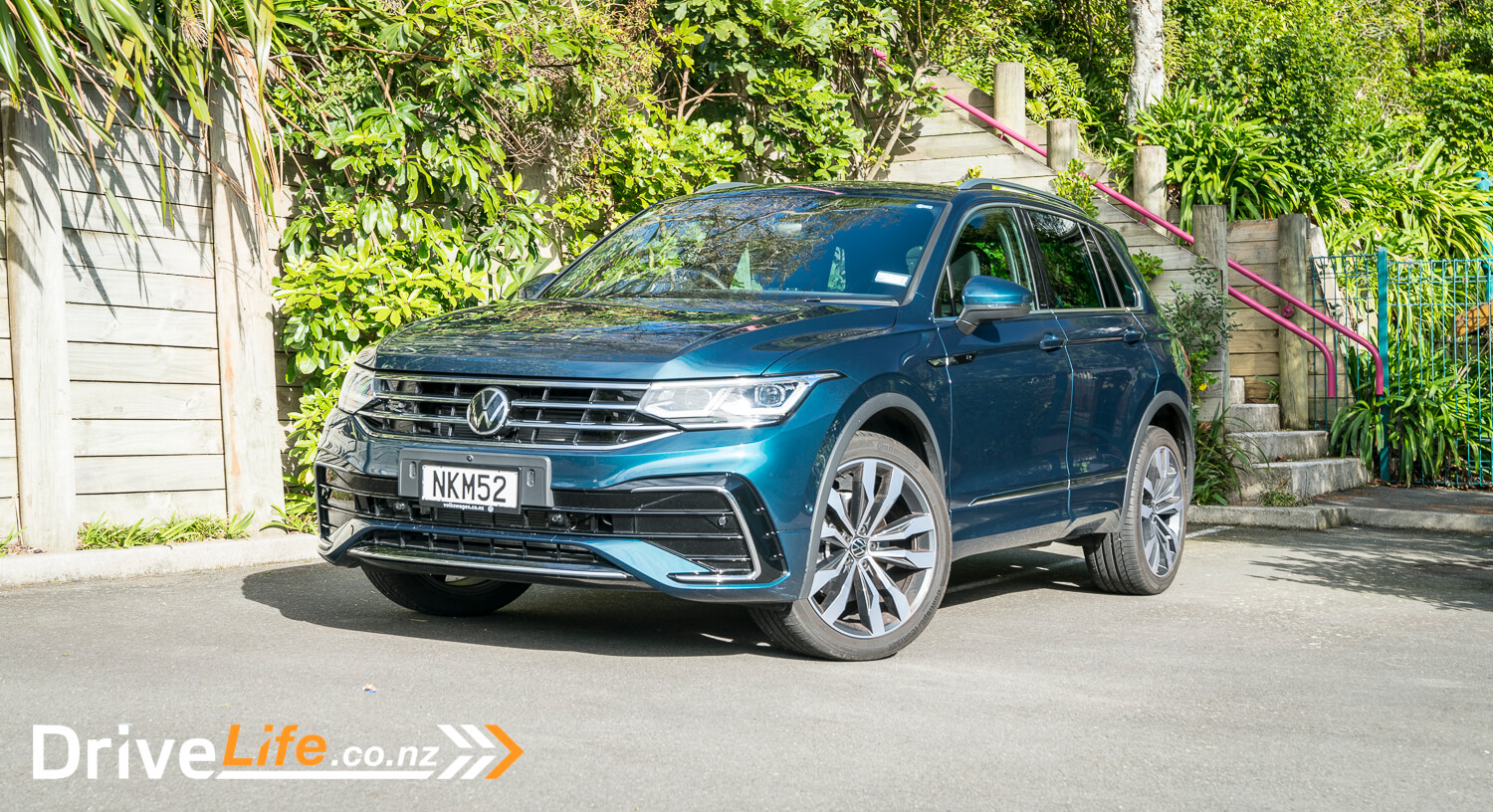
What’s The Competition For The 2021 Volkswagen Tiguan TSI R-Line?
Where the Tiguan has always shined is that it’s a good quality European brand without having the hefty price tag of Audi, BMW, Jaguar and Mercedes-Benz. So when you compare the models, you quickly find out that you get a top-spec model from VW where you still need to pay more for the base model from the other Euro brands. The only other brand that offers something similar and cheaper is Skoda with the Karoq SportLine.
| Brand / Model | Engine | Power kW/Nm | Number of Seats | Fuel L/100km | Boot Capacity Litres | Price Highest to Lowest |
| Jaguar P250 | 2.0-litre, 4-cylinder turbocharged | 184/365 | 5 | 9.3 | 650/1740 | $99,900 |
| Audi Q5 40 TDI | 2.0-litre, 4-cylinder turbo diesel | 150/400 | 5 | 5.4 | 520/1560 | $92,900 |
| Mercedes-Benz AMG GLC 200 | 2.0-litre, 4-cylinder turbocharged | 145/320 | 5 | 7.8 | 550/1600 | $90,400 |
| BMW X3 sDrive20i | 1.6-litre, 4-cylinder turbocharged | 125/250 | 5 | 8.3 | 550/1600 | $88,990 |
| VW Tiguan R-Line AWD | 2.0-litre, 4-cylinder turbocharged | 162/350 | 5 | 8.3 | 615/1655 | $68,900 |
| Skoda Karoq Sportline TSI | 2.0-litre, 4-cylinder turbocharged | 140/320 | 5 | 7.6 | 588/1630 | $55,990 |
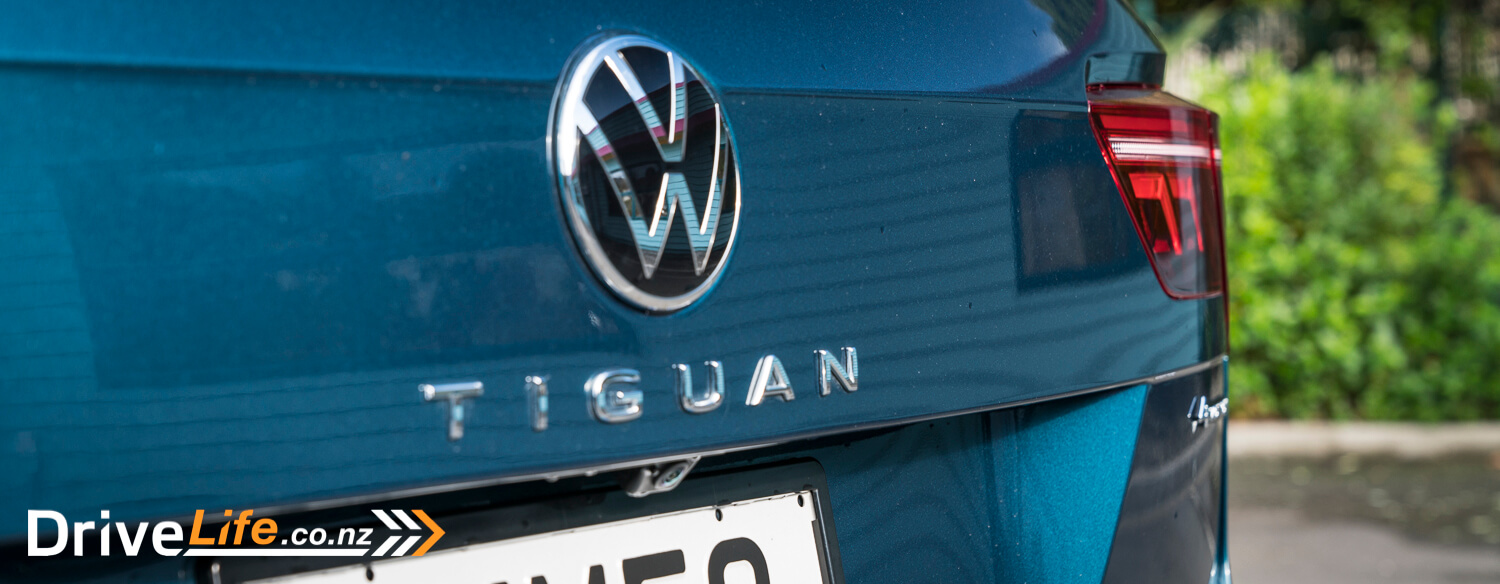
What’s The Pros And Cons For The 2021 Volkswagen Tiguan TSI R-Line?
PROS
- Strong modern styling
- Sporty and nimble
- Smooth and comfy ride
- Great build quality
- Beautiful handling
- Upmarket interior
- Tech level and safety features
- Great boot space
CONS
- Haptic steering wheel buttons
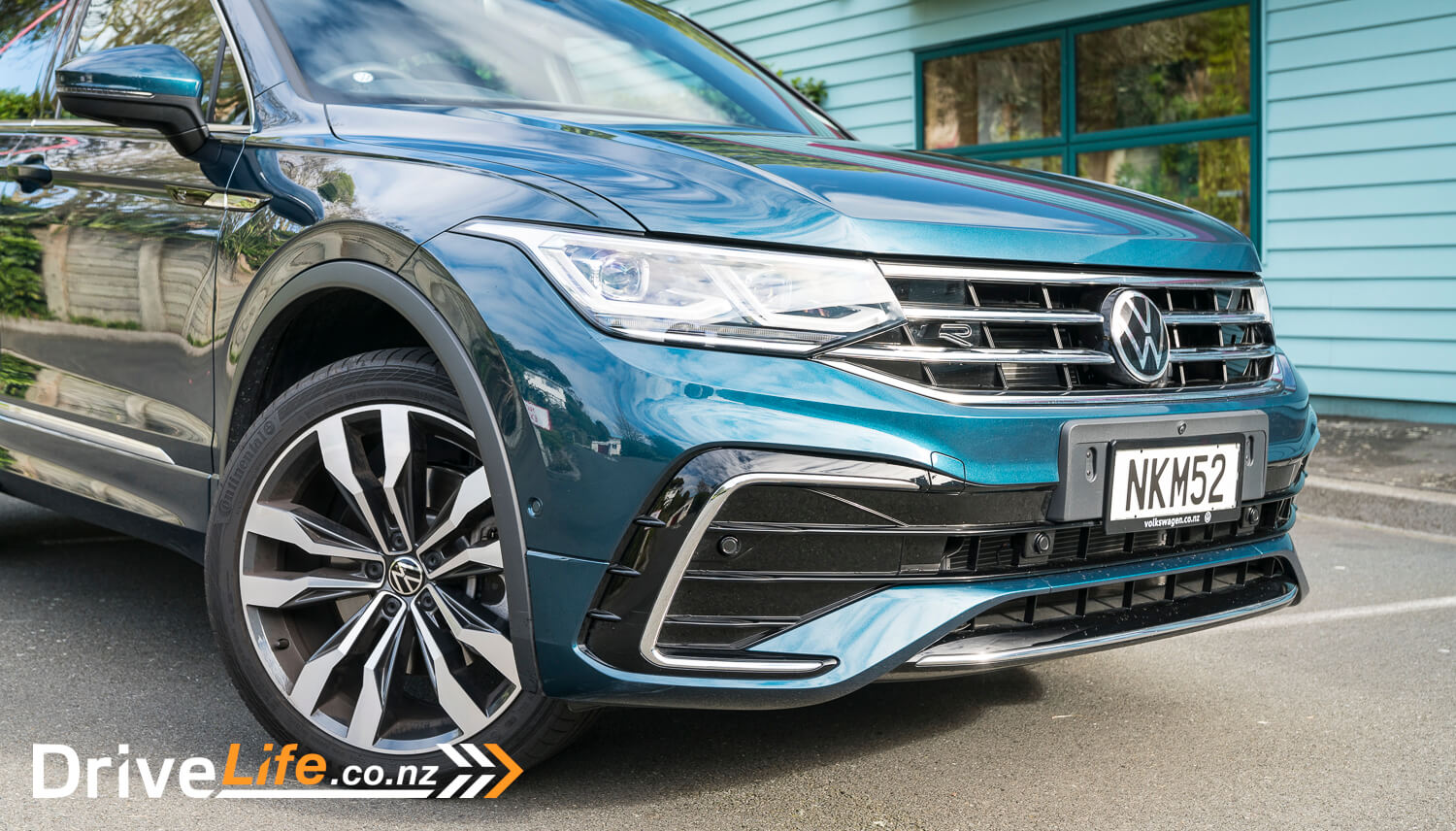
2021 VW Tiguan TSI R-Line AWD – Specifications
| Vehicle Type | Performance Compact SUV |
| Starting Price | $68,900 |
| Price as Tested | $68,900 |
| Engine | 2.0-litre petrol TFSI inline 4 |
| Power, Torque kW/Nm | 162/350 |
| Transmission | 7-Speed DSG |
| Spare Wheel | Space saver |
| Kerb Weight, Kg | 1,694 |
| Length x Width x Height, mm | 4511 x 1675 x 1859 |
| Cargo Capacity, litres | 615 / 1665 |
| Fuel tank capacity, litres | 63 |
| Fuel Economy, L/100km | Advertised Spec – Combined – 8.3 Real-World Test – Combined – 9.1 Low Usage: 0-6 / Medium Usage 6-12 / High Usage 12+ |
| Towing Capacity Kg unbraked/braked | 750 /2100 |
| Turning circle, metres | 11.5 Small: 6-10m / Medium 10-12m / Large 12m+ |
| Warranty | 5 years or 150,000km warranty |
| ANCAP Safety Ratings | 5 Star |


